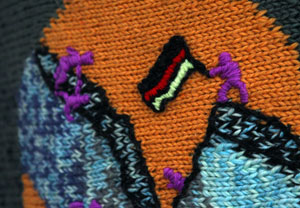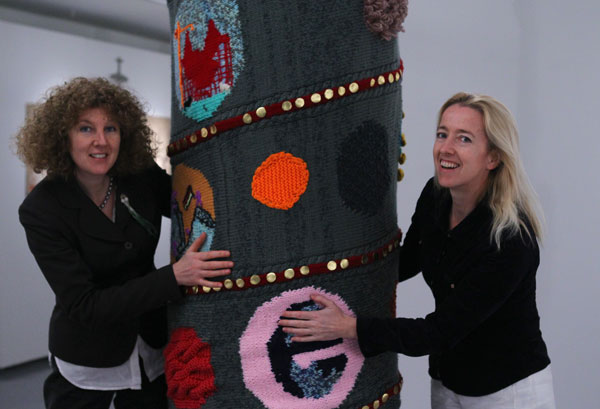Mechanics of art
Updated: 2012-03-25 07:47
By Han Bingbin (China Daily)
|
|||||||||||
|
The booming art market in China brings foreign artists, like Fion Gunn, more opportunities. Photos by Zou Hong / China Daily |
|
Irish artists Fion Gunn (left) and Niamh Cunningham. |

Growing up in an antique shop in Ireland, artist Fion Gunn's drawings during the formative years of her art learning were of jade, soap stone and Chinese landscapes.
For years, her interest in Chinese culture remained peacefully on paintings, till one day in 2002 the dramatic news about the Three Gorges being flooded down on the Yangtze River caused a stir in her heart.
With financial support from her husband, she was soon on a cheap tour to some of her dream spots around China, including the Three Gorges. During her short stay in Beijing, she went to an exhibition at the old Tsinghua art college, where the intriguing use of space and art made her determined to return as an artist.
In 2005, Gunn won a grant from Culture Ireland that funded an artist residency program in Beijing. Since that year, she has come back annually and held several solo exhibitions in the country.
In 2010, she launched Irish Wave, an art festival consisting of several exhibitions that featured works from both Chinese and Irish artists. The festival is running this month for the third year.
Like many other foreign artists, Gunn was grateful for the booming art market in China. Recalling the tight supply of galleries in London, where she has been based for 27 years as an artist and curator, Gunn says there are more and bigger spaces in China that bring in more opportunities. People here are generally more open to new ideas and fresh artists, she says.
Her extensive experiences in China have given her a good track record that creates more opportunities back in her home country.
But the disorganization of the emerging market here in China often pushes her to the limit. Due to logistical problems, some of the works didn't arrive in Beijing on time for this year's Irish Wave, so Gunn had to change some gallery layouts. Many spaces are so poorly maintained that key facilities are not prepared when needed.
"Everything is so last-minute. In some way, it's good because when the plan changes, you can be very flexible. But in other ways, it's hard to plan in advance," she says.
But on the other hand, all those difficulties have given Gunn pride in her own ability to grasp the overall situation, from writing press releases, negotiating with logistics companies to laying out the artworks. These skills don't fit the popular idea of inward-looking artists, but Gunn, practical at the age of 52, says artists cannot survive simply being artists.
"And if they are, they are very poor. You have to develop a wide range of skills to be able to cope with a difficult life," she says.
When Gunn started out with a bachelor's degree in sculpture at the age of 25 in London, there weren't any opportunities. She took part-time jobs to make ends meet: teaching, interior decorating and administrating charity organizations.
For a very long time, Gunn felt very frustrated because she thought other work took her away from her art. But she always kept a mental space for her artistic ideas and the works she wanted to do in the future.
"If you keep this mental space clear and allow yourself to think of these things, and if you make it the center of your intellectual life, then the time will come and you can go back to your work in a concentrated and effective way," she says.
Recently, she has been involved in a charity project in London called Streatham Women's Sewing Group. There, Gunn and her friend teach a group of Somalian refugee women basic sewing skills, bead work and embroidery. The works, such as a fabric-embroidered map of London and food sculpture made of clay, are then displayed in the community to close the division between these poor women and local people.
Before Gunn designs an art piece, she would ask for the women's ideas. It's challenging: She has to come up with a project where everybody can be involved even if they don't have very good skills. But the result must still be beautiful. For her, "this is about democratizing art, but it doesn't compromise on the quality of meaning or execution".
"It's been very educational and stimulating for me," she says. "Because it pushes you to other media and discovering other ways of doing work."
It's easy for artists to develop the essence of living in a parallel world, an observer's world, and Gunn says artists must keep their unique way of looking at things but stay connected with the ordinary world.
"It's not that artists should try to please the audiences, but you should understand where their ideas come from," she says. "As you open up your mind, other people can take a look at what your world looks like."
Contact the writer at hanbingbin@chinadaily.com.cn.

Today's Top News
Rescuers race against time for quake victims
Telecom workers restore links
Coal mine blast kills 18 in Jilin
Intl scholarship puts China on the map
More bird flu patients discharged
Gold loses sheen, but still a safe bet
US 'turns blind eye to human rights'
Telecom workers restore links
Hot Topics
Lunar probe , China growth forecasts, Emission rules get tougher, China seen through 'colored lens', International board,
Editor's Picks

|

|

|

|

|

|







